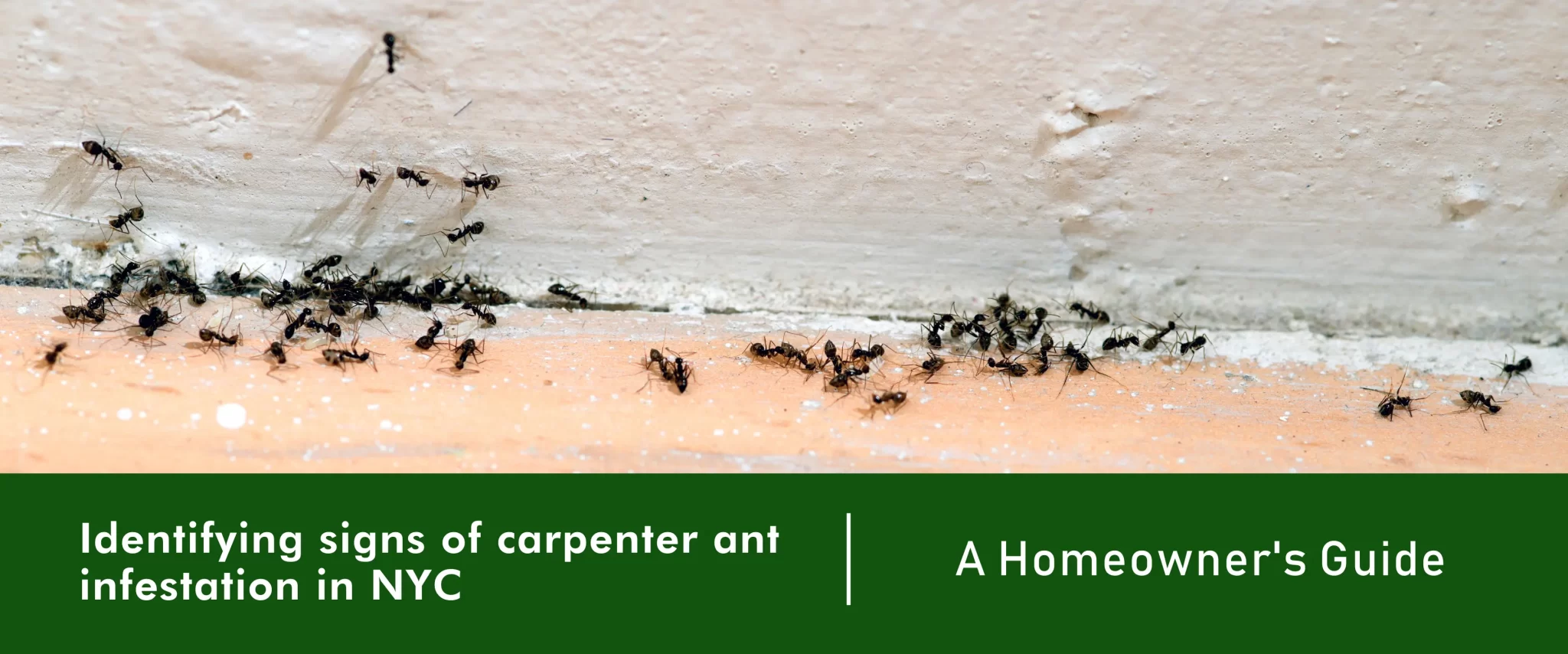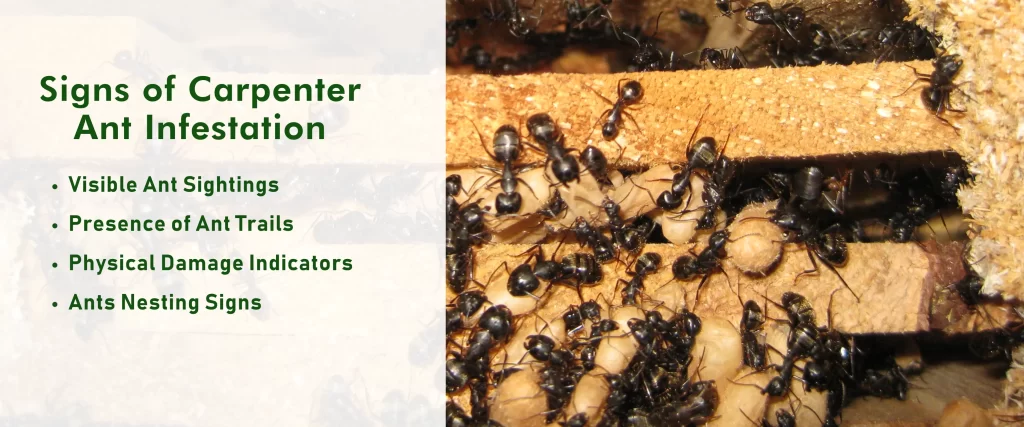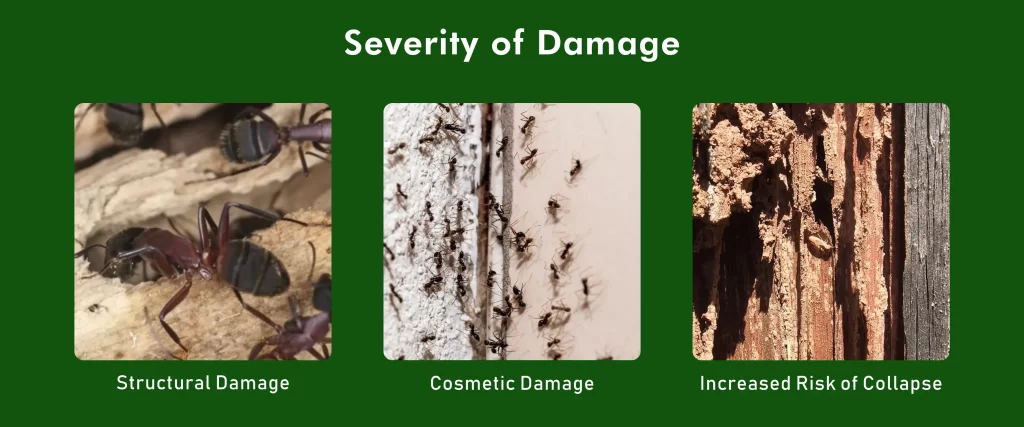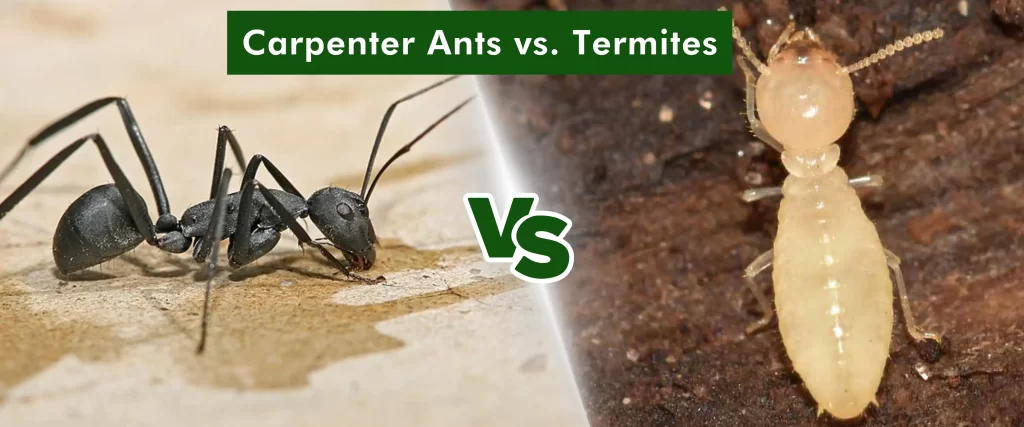
Identifying signs of carpenter ant infestation in NYC: A Homeowner’s Guide
Carpenter ants are a type of ant that can wreak havoc on your NYC home. Unlike their sugary-loving cousins, carpenter ants burrow through wood to create nests, potentially causing structural damage. Early detection is crucial to prevent significant repairs. This guide will equip you with the knowledge to identify a carpenter ant infestation and take action before it’s too late.
Understanding Carpenter Ants
What Are Carpenter Ants?
Carpenter ants are large ants (usually ½ inch to ¾ inch long) with black or reddish-black coloring. They have a distinctive “pinched-waist” and powerful mandibles for chewing wood. Unlike termites, which eat wood for sustenance, carpenter ants excavate tunnels and chambers within wood for nesting purposes.
Differentiating Carpenter Ants
It’s important to distinguish carpenter ants from other common ants. Carpenter ants are larger and have a more robust build compared to pavement ants or pharaoh ants. Unlike termites, which have straight antennae, carpenter ants have bent or “elbowed” antennae.
Why Are There Carpenter Ants in My House?
Carpenter ants are attracted to moisture and decaying wood. Common reasons for an infestation in your NYC home include:
- Moisture Issues: Leaky pipes, poor ventilation in damp areas, or improper drainage around the foundation can create a haven for carpenter ants.
- Wood Sources: Firewood stored close to the house, decaying decks, or overgrown tree branches touching the exterior can provide entry points and nesting sites.
Signs of Carpenter Ant Infestation

Visible Ant Sightings:
- Size and Color: Keep an eye out for large (½ inch to ¾ inch), black or reddish-black ants.
- Activity: Carpenter ants are most active at night. Seeing them foraging during the day might indicate a significant infestation.
Presence of Ant Trails:
- Look for lines of ants, particularly near baseboards, windows, or doorways, at night when they’re most active.
- These trails can lead you to their entry points or source of food.
Physical Damage Indicators:
- Frass: Piles of sawdust-like material (frass) near wooden structures like walls, floors, or furniture can indicate carpenter ant activity.
- Hollow-sounding Wood: Tapping on wooden beams, walls, or furniture might reveal a hollow sound, suggesting carpenter ant excavation within.
- Rustling Noises: Listen for rustling sounds within walls or behind wooden structures, which could be carpenter ants moving through their tunnels.
Ant Nesting Signs:
- Entry Points: Inspect the foundation, around pipes, and near windows and doors for small holes that could be carpenter ant entry points.
- Satellite Nests: Carpenter ants can establish satellite nests besides their main colony. Look for these inside walls, behind cabinets, or even outdoors near the house.
Do Carpenter Ants Cause Damage?
Absolutely! Carpenter ants are a destructive force in your NYC home, silently weakening its structure. While they might seem harmless, their tunneling habits can lead to significant damage.
Nature of Damage: Excavation, Not Consumption
Unlike termites, which devour wood for sustenance, carpenter ants are excavators. They use their strong mandibles to chew tunnels and chambers within wood to create nesting sites. This process creates a rough, sawdust-like material called frass, which you might find near damaged areas.
Carpenter Ants vs. Termites: Damage Comparison
Both carpenter ants and termites can wreak havoc on your home, but their methods differ:
- Termite Damage: Termites silently eat wood from the inside out, leaving a hollow shell that may go unnoticed for a long time. Their damage can be extensive before any signs appear.
- Carpenter Ant Damage: Carpenter ants create visible tunnels and chambers within the wood, weakening its structure and integrity. The damage is more apparent, allowing for earlier detection.
Severity of Damage: Beyond Aesthetics

A carpenter ant infestation can quickly escalate from a nuisance to a major structural concern. Here’s how:
- Structural Damage: Weakened floor joists, beams, and support structures can compromise the stability of your home. This can lead to sagging floors, uneven walls, and even potential collapse in severe cases.
- Cosmetic Damage: Damaged walls, ceilings, and floors can be unsightly and detract from the value of your home. Repairing these areas can be a significant undertaking.
- Increased Risk of Collapse: Extensive carpenter ant damage can lead to structural failure, posing a serious safety hazard to you and your family.
Impact on Home Integrity and Repair Costs
Carpenter ant infestations are a double whammy for your NYC home:
- Decreased Home Value: Extensive damage caused by these ants can significantly decrease your home’s market value.
- Costly Repairs: Repairing structural damage caused by carpenter ants can be expensive. Replacing beams, floor joists, or sections of walls can cost tens of thousands of dollars.
Early detection is key. The sooner you address a carpenter ant infestation, the less damage they can cause and the lower the repair costs will be.
Are Carpenter Ants Bad?
Yes, carpenter ants pose a threat to your health, safety, and wallet in several ways.
Health and Safety Concerns: Bites and Air Quality
- Allergic Reactions: Carpenter ant bites can cause irritation, swelling, and even allergic reactions in some people. While their bites are not dangerous for everyone, they can be uncomfortable and require medical attention in some cases.
- Indoor Air Quality: The presence of carpenter ants and their frass can contribute to dust and allergens, potentially impacting indoor air quality and triggering respiratory problems for those with allergies or asthma.
Economic Impact: A Double-Edged Sword
- Extermination Costs: Getting rid of a carpenter ant infestation requires professional treatment, which can be expensive depending on the severity of the infestation.
- Repair Costs: As discussed earlier, repairing structural damage caused by carpenter ants can be a significant financial burden.
- Long-Term Implications: Left untreated, carpenter ant infestations can lead to extensive damage, potentially requiring major renovations and costing tens of thousands of dollars. Early detection and treatment can save you a significant amount of money in the long run.
Are Carpenter Ants as Bad as Termites?

While both carpenter ants and termites can damage your NYC home, they differ significantly in their behavior and the consequences of infestation. Here’s a breakdown:
Comparison Overview
- Diet: Carpenter ants excavate wood for nesting, while termites eat wood for sustenance.
- Damage: Carpenter ants create tunnels weakening structures, while termites consume wood from the inside out, leaving hollow shells that may go unnoticed for a long time.
Infestation Consequences
- Long-Term Damage: Termite infestations are generally considered more destructive because their constant wood consumption can lead to hidden, extensive structural damage before any signs appear. Early detection of carpenter ant damage is easier due to their visible tunneling.
- Detection and Eradication: Carpenter ant infestations are often easier to detect due to their visible activity and frass piles. However, eliminating them can be challenging because they can establish satellite nests. Termite infestations are often trickier to detect initially, but professional treatment can be more effective due to the centralized nature of their colonies.
How to Deal with Carpenter Ant Infestation
Immediate Steps:
- Identify and Eliminate Moisture Sources: Fix leaky pipes, address condensation issues, and ensure proper ventilation in crawlspaces and basements to remove moisture that attracts carpenter ants.
- Seal Entry Points: Inspect your foundation, around pipes, windows, and doors for small holes that carpenter ants might use to enter. Seal these openings with caulk or mortar to prevent them from coming inside.
Professional Intervention:
- When to Call an Exterminator: If you see multiple carpenter ants, discover trails, or suspect an infestation, call a professional exterminator immediately. Early intervention is crucial to prevent extensive damage.
- Professional Inspection and Treatment: A qualified exterminator will conduct a thorough inspection to locate the nest(s) and identify the species. They will then develop a treatment plan that may involve bait stations, liquid applications, or a combination of methods to eliminate the colony.
Preventive Measures:
- Regular Home Maintenance: Address any moisture issues promptly. Repair leaky faucets, ensure proper drainage around the foundation, and store firewood away from the house.
- Minimize Attractants: Keep food crumbs, spills, and sugary substances cleaned up. Store food in sealed containers and dispose of garbage regularly.
- Trim Tree Branches: Keep tree branches and other vegetation away from your house to eliminate potential entry points for carpenter ants.
Conclusion
Carpenter ants, while not as stealthy as termites, can pose a significant threat to your NYC home’s structural integrity. Early detection and intervention are crucial to prevent them from causing extensive damage. By familiarizing yourself with the signs of a carpenter ant infestation and taking proactive measures, you can safeguard your property.
Taking Action is Key
Ignoring a carpenter ant infestation can lead to costly repairs down the line. Regularly inspect your home for signs of these ants, such as visible trails, frass piles, or hollow-sounding wood. Don’t hesitate to take action – the sooner you address the issue, the easier and less expensive it will be to eradicate them.
Call a Professional
If you suspect a carpenter ant infestation in your NYC home, don’t attempt to tackle it yourself. Contact a qualified pest control professional. They have the expertise in ant control and tools necessary to locate the nest(s), eliminate the colony, and prevent future problems.
FAQs
How Do I Know If I Have Carpenter Ants?
Look for large black or reddish-black ants (½ inch to ¾ inch long), trails of ants, especially at night, and signs of physical damage like frass piles, hollow-sounding wood, or rustling noises within walls.
Do Carpenter Ants Cause Damage?
Yes! Carpenter ants excavate tunnels within wood to create nests, weakening structures. This can lead to damaged walls, floors, beams, and even potential collapse in severe cases.
Why Are There Carpenter Ants in My House?
Carpenter ants are attracted to moisture and decaying wood. Leaky pipes, poor ventilation, or firewood stored near the house can create an inviting environment for them.
Are Carpenter Ants Bad?
Yes. Carpenter ants can cause structural damage, trigger allergic reactions with their bites, and worsen indoor air quality with their frass. Additionally, the cost of repairs and extermination can be significant if left untreated.
Are Carpenter Ants as Bad as Termites?
Both are destructive, but in different ways. Carpenter ant damage is more noticeable due to their tunneling, while termites eat wood from the inside out, causing hidden damage. Termite infestations can be harder to detect initially, but professional treatment can be more effective due to their centralized colonies.
How to Know If You Have a Carpenter Ant Infestation?
By being observant! Look for the signs mentioned earlier, such as large black or reddish-black ants, trails of ants, frass piles, hollow-sounding wood, or rustling noises within walls. If you see any of these signs, contact a professional exterminator for a thorough inspection and treatment plan.


